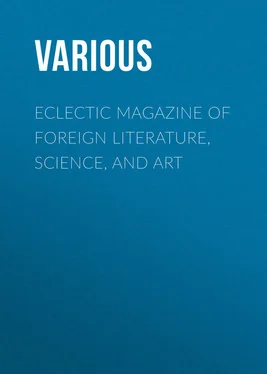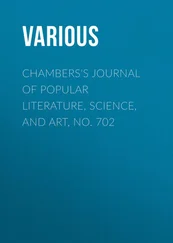Various - Eclectic Magazine of Foreign Literature, Science, and Art
Здесь есть возможность читать онлайн «Various - Eclectic Magazine of Foreign Literature, Science, and Art» — ознакомительный отрывок электронной книги совершенно бесплатно, а после прочтения отрывка купить полную версию. В некоторых случаях можно слушать аудио, скачать через торрент в формате fb2 и присутствует краткое содержание. Жанр: foreign_home, на английском языке. Описание произведения, (предисловие) а так же отзывы посетителей доступны на портале библиотеки ЛибКат.
- Название:Eclectic Magazine of Foreign Literature, Science, and Art
- Автор:
- Жанр:
- Год:неизвестен
- ISBN:нет данных
- Рейтинг книги:4 / 5. Голосов: 1
-
Избранное:Добавить в избранное
- Отзывы:
-
Ваша оценка:
- 80
- 1
- 2
- 3
- 4
- 5
Eclectic Magazine of Foreign Literature, Science, and Art: краткое содержание, описание и аннотация
Предлагаем к чтению аннотацию, описание, краткое содержание или предисловие (зависит от того, что написал сам автор книги «Eclectic Magazine of Foreign Literature, Science, and Art»). Если вы не нашли необходимую информацию о книге — напишите в комментариях, мы постараемся отыскать её.
Eclectic Magazine of Foreign Literature, Science, and Art — читать онлайн ознакомительный отрывок
Ниже представлен текст книги, разбитый по страницам. Система сохранения места последней прочитанной страницы, позволяет с удобством читать онлайн бесплатно книгу «Eclectic Magazine of Foreign Literature, Science, and Art», без необходимости каждый раз заново искать на чём Вы остановились. Поставьте закладку, и сможете в любой момент перейти на страницу, на которой закончили чтение.
Интервал:
Закладка:
Various
Eclectic Magazine of Foreign Literature, Science, and Art
MOUNTAIN OBSERVATORIES
On October 1st, 1876, one of the millionaires of the New World died at San Francisco. Although owning a no more euphonious name than James Lick, he had contrived to secure a future for it. He had founded and endowed the first great astronomical establishment planted on the heights, between the stars and the sea. How he came by his love of science we have no means of knowing. Born obscurely at Fredericksburg, in Pennsylvania, August 25th, 1796, he amassed some 30,000 dollars by commerce in South America, and in 1847 transferred them and himself to a village which had just exchanged its name of Yerba Buena for that of San Francisco, situate on a long, sandy strip of land between the Pacific and a great bay. In the hillocks and gullies of that wind-blown barrier he invested his dollars, and never did virgin soil yield a richer harvest. The gold-fever broke out in the spring of 1848. The unremembered cluster of wooden houses, with no trouble or tumult of population in their midst, nestling round a tranquil creek under a climate which, but for a touch of sea-fog, might rival that of the Garden of the Hesperides, became all at once a centre of attraction to the outcast and adventurous from every part of the world. Wealth poured in; trade sprang up; a population of six hundred increased to a quarter of a million; hotels, villas, public edifices, places of business spread, mile after mile, along the bay; building-ground rose to a fabulous price, and James Lick found himself one of the richest men in the United States.
Thus he got his money; we have now to see how he spent it. Already the munificent benefactor of the learned institutions of California, he in 1874 formally set aside a sum of two million dollars for various public purposes, philanthropic, patriotic, and scientific. Of these two millions 700,000 were appropriated to the erection of a telescope “superior to, and more powerful than any ever yet made.” But this, he felt instinctively, was not enough. Even in astronomy, although most likely unable to distinguish the Pole-star from the Dog-star, this “pioneer citizen” could read the signs of the times. It was no longer instruments that were wanted; it was the opportunity of employing them. Telescopes of vast power and exquisite perfection had ceased to be a rarity; but their use seemed all but hopelessly impeded by the very conditions of existence on the surface of the earth.
The air we breathe is in truth the worst enemy of the astronomer’s observations. It is their enemy in two ways. Part of the sight which brings its wonderful, evanescent messages across inconceivable depths of space, it stops; and what it does not stop, it shatters. And this even when it is most transparent and seemingly still; when mist-veils are withdrawn, and no clouds curtain the sky. Moreover, the evil grows with the power of the instrument. Atmospheric troubles are magnified neither more nor less than the objects viewed across them. Thus, Lord Rosse’s giant reflector possesses — nominally – a magnifying power of 6,000; that is to say, it can reduce the apparent distances of the heavenly bodies to 1/6000 their actual amount. The moon, for example, which is in reality separated from the earth’s surface by an interval of about 234,000 miles, is shown as if removed only thirty-nine miles. Unfortunately, however, in theory only. Professor Newcomb compares the sight obtained under such circumstances to a glimpse through several yards of running water, and doubts whether our satellite has ever been seen to such advantage as it would be if brought – substantially, not merely optically – within 500 miles of the unassisted eye. 1 1 Popular Astronomy, p. 145.
Must, then, all the growing triumphs of the optician’s skill be counteracted by this plague of moving air? Can nothing be done to get rid of, or render it less obnoxious? Or is this an ultimate barrier, set up by Nature herself, to stop the way of astronomical progress? Much depends upon the answer – more than can, in a few words, be easily made to appear; but there is fortunately reason to believe that it will, on the whole, prove favorable to human ingenuity, and the rapid advance of human knowledge on the noblest subject with which it is or ever can be conversant.
The one obvious way of meeting atmospheric impediments is to leave part of the impeding atmosphere behind; and this the rugged shell of our planet offers ample means of doing. Whether the advantages derived from increased altitudes will outweigh the practical difficulties attending such a system of observation when conducted on a great scale, has yet to be decided. The experiment, however, is now about to be tried simultaneously in several parts of the globe.
By far the most considerable of these experiments is that of the “Lick Observatory.” Its founder was from the first determined that the powers of his great telescope should, as little as possible, be fettered by the hostility of the elements. The choice of its local habitation was, accordingly, a matter of grave deliberation to him for some time previous to his death. Although close upon his eightieth year, he himself spent a night upon the summit of Mount St. Helena with a view to testing its astronomical capabilities, and a site already secured in the Sierra Nevada was abandoned on the ground of climatic disqualifications. Finally, one of the culminating peaks of the Coast Range, elevated 4,440 feet above the sea, was fixed upon. Situated about fifty miles south-east of San Francisco, Mount Hamilton lies far enough inland to escape the sea-fog, which only on the rarest occasions drifts upward to its triple crest. All through the summer the sky above it is limpid and cloudless; and though winter storms are frequent, their raging is not without highly available lucid intervals. As to the essential point – the quality of telescopic vision – the testimony of Mr. S. W. Burnham is in the highest degree encouraging. This well-known observer spent two months on the mountain in the autumn of 1879, and concluded, as the result of his experience during that time – with the full concurrence of Professor Newcomb – that, “it is the finest observing location in the United States.” Out of sixty nights he found forty-two as nearly perfect as nights can well be, seven of medium quality, and only eleven cloudy or foggy; 2 2 The Observatory, No. 43, p. 613.
his stay, nevertheless, embraced the first half of October, by no means considered to belong to the choice part of the season. Nor was his trip barren of discovery. A list of forty-two new double stars gave an earnest of what may be expected from systematic work in such an unrivalled situation. Most of these are objects which never rise high enough in the sky to be examined with any profit through the grosser atmosphere of the plains east of the Rocky Mountains; some are well-known stars, not before seen clearly enough for the discernment of their composite character; yet Mr. Burnham used the lesser of two telescopes – a 6-inch and an 18-inch achromatic – with which he had been accustomed to observe at Chicago.
The largest refracting telescope as yet actually completed has a light-gathering surface 27 inches in diameter. This is the great Vienna equatorial, admirably turned out by Mr. Grubb, of Dublin, in 1880, but still awaiting the commencement of its exploring career. It will, however, soon be surpassed by the Pulkowa telescope, ordered more than four years ago on behalf of the Russian Government from Alvan Clark and Sons, of Cambridgeport, Massachusetts. Still further will it be surpassed by the coming “Lick Refractor.” It is safe to predict that the optical championship of the world is, at least for the next few years, secured to this gigantic instrument, the completion of which may be looked for in the immediate future. It will have a clear aperture of three feet . A disc of flint-glass for the object-lens, 38·18 inches across, and 170 kilogrammes in weight, was cast at the establishment of M. Feil, in Paris, early in 1882. Four days were spent and eight tons of coal consumed in the casting of this vast mass of flawless crystal; it took a calendar month to cool, and cost 2,000 l. 3 3 Nature, vol. xxv. p. 537.
It may be regarded as the highest triumph so far achieved in the art of optical glass-making.
Интервал:
Закладка:
Похожие книги на «Eclectic Magazine of Foreign Literature, Science, and Art»
Представляем Вашему вниманию похожие книги на «Eclectic Magazine of Foreign Literature, Science, and Art» списком для выбора. Мы отобрали схожую по названию и смыслу литературу в надежде предоставить читателям больше вариантов отыскать новые, интересные, ещё непрочитанные произведения.
Обсуждение, отзывы о книге «Eclectic Magazine of Foreign Literature, Science, and Art» и просто собственные мнения читателей. Оставьте ваши комментарии, напишите, что Вы думаете о произведении, его смысле или главных героях. Укажите что конкретно понравилось, а что нет, и почему Вы так считаете.












